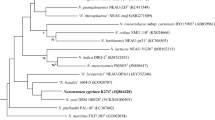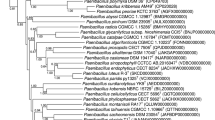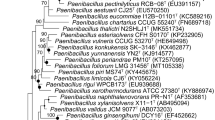Abstract
Four bacterial strains, designated M89, M92, M97T, and M106, were isolated in a previous study from surface-sterilized leaves of rice (Oryza sativa) or murainagrass (Ischaemum rugosum) at three sites in Mali, Africa. Here they were examined by a polyphasic taxonomic approach and analysis of a whole-genome sequence. Phylogenetic analyses based on 16S rRNA sequence and multilocus sequence analysis of seven genes showed that these four strains formed a distinct lineage representing a novel species within the genus Xanthomonas. This was supported by whole-genome average nucleotide identity values calculated from comparisons of strain M97T with established Xanthomonas species. The strains can be differentiated from the known Xanthomonas species on the basis of their fatty acid and carbohydrate utilization profiles. Population growth studies on rice confirmed that these bacteria multiply in rice leaves without causing symptoms. Identification of this novel species can be accomplished by using diagnostic primer sets or by gyrB gene sequence analysis. We propose to classify these rice- and grass-associated bacteria as Xanthomonas maliensis sp. nov. with strain M97T = CFBP7942T = LMG27592T as the type strain.



Similar content being viewed by others
References
Brady C, Cleenwerck I, Venter S, Coutinho T, De Vos P (2013) Taxonomic evaluation of the genus Enterobacter based on multilocus sequence analysis (MLSA): proposal to reclassify E. nimipressuralis and E. amnigenus into Lelliottia gen. nov. as Lelliottia nimipressuralis comb. nov. and Lelliottia amnigena comb. nov., respectively, E. gergoviae and E. pyrinus into Pluralibacter gen. nov. as Pluralibacter gergoviae comb. nov. and Pluralibacter pyrinus comb. nov., respectively, E. cowanii, E. radicincitans, E. oryzae and E. arachidis into Kosakonia gen. nov. as Kosakonia cowanii comb. nov., Kosakonia radicincitans comb. nov., Kosakonia oryzae comb. nov. and Kosakonia arachidis comb. nov., respectively, and E. turicensis, E. helveticus and E. pulveris into Cronobacter as Cronobacter zurichensis nom. nov., Cronobacter helveticus comb. nov. and Cronobacter pulveris comb. nov., respectively, and emended description of the genera Enterobacter and Cronobacter. Syst Appl Microbiol 36:309–319
Chang H-W, Nam Y-D, Jung MY, Kim K-H, Roh SW, Kim M-S, Jeon CO, Yoon J-H, Bae J-W (2008) Statistical superiority of genome-probing microarrays as genomic DNA-DNA hybridization in revealing the bacterial phylogenetic relationship compared to conventional methods. J Microbiol Methods 75:523–530
Cottyn B, Regalado E, Lanoot B, De Cleene M, Mew TW, Swings J (2001) Bacterial populations associated with rice seed in the tropical environment. Phytopathology 91:282–292
Cottyn B, Debode J, Regalado E, Mew TW, Swings J (2009) Phenotypic and genetic diversity of rice seed-associated bacteria and their role in pathogenicity and biological control. J Appl Microbiol 107:885–897
Delcher AL, Phillippy A, Carlton J, Salzberg SL (2002) Fast algorithms for large-scale genome alignment and comparison. Nucleic Acids Res 30:2478–2483
Goris J, Konstantinidis KT, Klappenbach JA, Coenye T, Vandamme P, Tiedje JM (2007) DNA-DNA hybridization values and their relationship to whole-genome sequence similarities. Int J Syst Evol Microbiol 57:81–91
Hauben L, Vauterin L, Swings J, Moore ERB (1997) Comparison of 16S ribosomal DNA sequences of all Xanthomonas species. Int J Syst Bacteriol 47:328–335
Jimenez G, Urdiain M, Cifuentes A, Lopez-Lopez A, Blanch AR, Tamames J, Kampfer P, Kolsto A-B, Ramon D, Martinez JF, Codoner FM, Rossello-Mora R (2013) Description of Bacillus toyonensis sp. nov., a novel species of the Bacillus cereus group, and pairwise genome comparisons of the species of the group by means of ANI calculations. Syst Appl Microbiol 36:383–391
Jones JB, Lacy GH, Bouzar H, Stall RE, Schaad NW (2004) Reclassification of the xanthomonads associated with bacterial spot disease of tomato and pepper. Syst Appl Microbiol 27:755–762
Karganilla A, Paris-Natural M, Ou SH (1973) A comparative study of culture media for Xanthomonas oryzae. Philipp Agric 57:141–152
Kauffman H, Reddy A, Hsiek S, Merca S (1973) An improved technique for evaluating resistance of rice varieties to Xanthomonas oryzae. Plant Dis Rep 57:537–541
Koressaar T, Remm M (2007) Enhancements and modifications of primer design program Primer3. Bioinformatics 23:1289–1291
Lee K, Park S-C, Yi H, Chun J (2013) Flavobacterium limnosediminis sp. nov., isolated from sediment of a freshwater lake. Int J Syst Evol Microbiol 63:4784–4789
Martens M, Dawyndt P, Coopman R, Gillis M, De Vos P, Willems A (2008) Advantages of multilocus sequence analysis for taxonomic studies: a case study using 10 housekeeping genes in the genus Ensifer (including former Sinorhizobium). Int J Syst Evol Microbiol 58:200–214
Mew TW, Misra JK (1994) A manual of rice seed health testing. International Rice Research Institute, Los Baños
Parkinson N, Aritua V, Heeney J, Cowie C, Bew J, Stead D (2007) Phylogenetic analysis of Xanthomonas species by comparison of partial gyrase B gene sequences. Int J Syst Evol Microbiol 57:2881–2887
Parkinson N, Cowie C, Heeney J, Stead D (2009) Phylogenetic structure of Xanthomonas determined by comparison of gyrB sequences. Int J Syst Evol Microbiol 59:264–274
Rademaker JL, Hoste B, Louws FJ, Kersters K, Swings J, Vauterin L, Vauterin P, de Bruijn FJ (2000) Comparison of AFLP and rep-PCR genomic fingerprinting with DNA-DNA homology studies: Xanthomonas as a model system. Int J Syst Evol Microbiol 50:665–677
Reimers PJ, Leach JE (1991) Race-specific resistance to Xanthomonas oryzae pv. oryzae conferred by bacterial blight resistance gene Xa-10 in rice Oryza sativa involves accumulation of a lignin-like substance in host tissues. Physiol Mol Plant Pathol 38:39–55
Rice P, Longden I, Bleasby A (2000) EMBOSS: the European molecular biology open software suite. Trends Genet 16:276–277
Richter M, Rossello-Mora R (2009) Shifting the genomic gold standard for the prokaryotic species definition. Proc Natl Acad Sci USA 106:19126–19131
Saitou N, Nei M (1987) The neighboring-joining method: a new method for reconstructing phylogenetic trees. Mol Biol Evol 4:406–425
Schaad NW, Jones JB, Chun W (2001) Laboratory guide for identification of plant pathogenic bacteria. APS press, Minnesota
Schaad NW, Postnikova E, Lacy GH, Sechler A, Agarkova I, Stromberg PE, Stromberg VK, Vidaver AK (2005) Reclassification of Xanthomonas campestris pv. citri (ex Hasse 1915) Dye 1978 forms A, B/C/D, and E as X. smithii subsp. citri (ex Hasse) sp. nov. nom. rev. comb. nov., X. fuscans subsp. aurantifolii (ex Gabriel 1989) sp. nov. nom. rev. comb. nov., and X. alfalfae subsp. citrumelo (ex Riker and Jones) Gabriel et al., 1989 sp. nov. nom. rev. comb. nov.; X. campestris pv malvacearum (ex Smith 1901) Dye 1978 as X. smithii subsp. smithii nov. comb. nov. nom. nov.; X. campestris pv. alfalfae (ex Riker and Jones, 1935) Dye 1978 as X. alfalfae subsp. alfalfae (ex Riker et al., 1935) sp. nov. nom. rev.; and “var. fuscans” of X. campestris pv. phaseoli (ex Smith, 1987) Dye 1978 as X. fuscans subsp. fuscans sp. nov. Syst Appl Microbiol 28:494–518
Tamura K, Nei M, Kumar S (2004) Prospects for inferring very large phylogenies by using the neighbor-joining method. Proc Natl Acad Sci USA 101:11030–11035
Tamura K, Peterson D, Peterson N, Stecher G, Nei M, Kumar S (2011) MEGA5: molecular evolutionary genetics analysis using maximum likelihood, evolutionary distance, and maximum parsimony methods. Mol Biol Evol 28:2731–2739
Thompson JD, Higginsand DG, Gibson TJ (1994) CLUSTAL W: improving the sensitivity of progressive multiple sequence alignment through sequence weighting, positions-specific gap penalties and weight matrix choice. Nucleic Acids Res 22:4673–4680
Trebaol G, Gardan L, Manceau C, Tanguy JL, Tirilly Y, Boury S (2000) Genomic and phenotypic characterization of Xanthomonas cynarae sp. nov., a new species that causes bacterial bract spot of artichoke (Cynara scolymus L.). IntJ Syst Evol Microbiol 50:1471–1478
Van den Mooter M, Swings J (1990) Numerical analysis of 295 phenotypic features of 266 Xanthomonas strains and related strains and an improved taxonomy of the genus. Int J Syst Bacteriol 40:348–369
Vandroemme J, Cottyn B, Pothier JF, Pflüger V, Duffy B, Maes M (2013) Xanthomonas arboricola pv. fragariae: what’s in a name? Plant Pathol 62:1123–1131
Vauterin L, Hoste B, Kersters K, Swings J (1995) Reclassification of Xanthomonas. Int J Syst Bacteriol 45:472–489
Vauterin L, Yang P, Alvarez A, Takikawa Y, Roth DA, Vidaver AK, Stall RE, Kersters K, Swings J (1996a) Identification of non-pathogenic Xanthomonas strains associated with plants. Syst Appl Microbiol 19:96–105
Vauterin L, Yang P, Swings J (1996b) Utilization of fatty acid methyl esters for the differentiation of new Xanthomonas species. Int J Syst Bacteriol 46:298–304
White FF, Potnis N, Jones JB, Koebnik R (2009) The type III effectors of Xanthomonas. Mol Plant Pathol 10:749–766
Wonni I, Cottyn B, Detemmerman L, Dao S, Ouedraogo L, Sarra S, Tekete C, Poussier S, Corral R, Triplett L, Koita O, Koebnik R, Leach J, Szurek B, Maes M, Verdier V (2014) Analysis of Xanthomonas oryzae pv. oryzicola population in Mali and Burkina Faso reveals a high level of genetic and pathogenic diversity. Phytopathology 104:520–531
Ye J, Coulouris G, Zaretskaya I, Cutcutache I, Rozen S, Madden TL (2012) Primer-BLAST: a tool to design target-specific primers for polymerase chain reaction. BMC Bioinform 13:134
Young JM, Dye DW, Bradbury JF, Panagopoulos CG, Robbs CF (1978) A proposed nomenclature and classification for plant pathogenic bacteria. N. Z. J Agric Res 21:153–177
Young JM, Park DC, Shearman HM, Fargier E (2008) A multilocus sequence analysis of the genus Xanthomonas. Syst Appl Microbiol 31:366–377
Young JM, Wilkie JP, Park DC, Watson DRW (2010) New Zealand strains of plant pathogenic bacteria classified by multi-locus sequence analysis; proposal of Xanthomonas dyei sp. nov. Plant Pathol 59:270–281
Acknowledgments
This work was supported by United States Department of Agriculture Grants 2011-67012-30670 and USDA-CSREES-2006-55605-16645 and by a grant from the Colorado State University Programs of Research and Scholarly Excellence (PRSE). V. Verdier (IRD) was supported by a Marie Curie International Outgoing Fellowship (EU Grant PIOF-GA-2009-235457) at CSU (Bioagricultural Sciences and Plant Management).The BCCM/LMG Bacteria Collection is supported by the Federal Public Planning Service - Science Policy, Belgium.
Author information
Authors and Affiliations
Corresponding author
Additional information
The Genbank accession numbers for the gene sequences referenced in this paper are KF306102-KF306211 (housekeeping genes) and KF992841-KF992843 (16S RNA genes).The accession for the draft genome sequence of Xanthomonas maliensis M97T is AQPR00000000.
Electronic supplementary material
Below is the link to the electronic supplementary material.
Rights and permissions
About this article
Cite this article
Triplett, L.R., Verdier, V., Campillo, T. et al. Characterization of a novel clade of Xanthomonas isolated from rice leaves in Mali and proposal of Xanthomonas maliensis sp. nov.. Antonie van Leeuwenhoek 107, 869–881 (2015). https://doi.org/10.1007/s10482-015-0379-5
Received:
Accepted:
Published:
Issue Date:
DOI: https://doi.org/10.1007/s10482-015-0379-5




